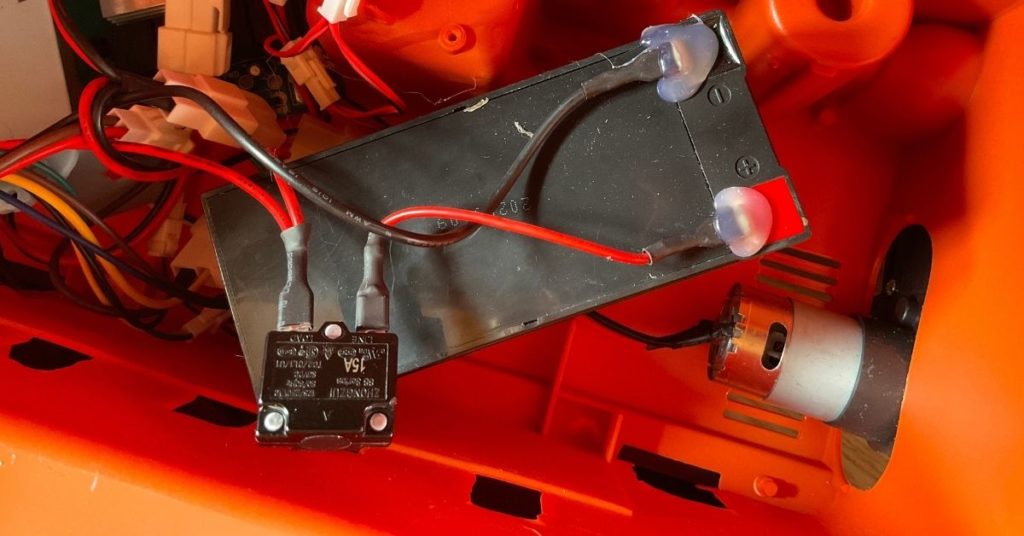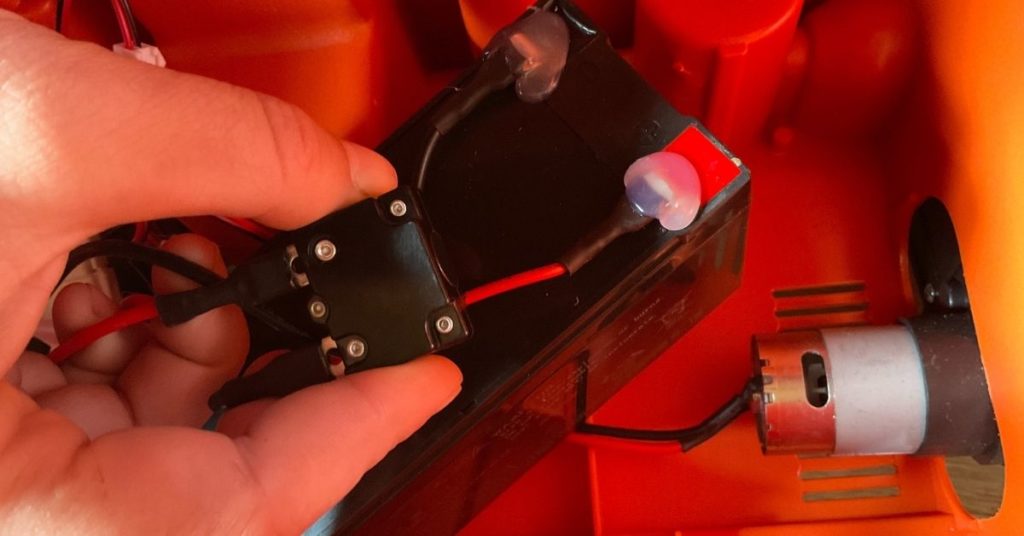My kid’s Power Wheel stopped working, and I opened up the whole thing to find out why. Turns out it was the thermal fuse. Since you are here to find a solution to the same problem I am explaining the thermal fuse and its problems in this article, and trust me; you do not need to be an engineer to solve them.
Table of Contents
What Is a Thermal Fuse?
A thermal fuse is a safety device. Consider it as a smoke detector for electronic appliances. Whenever a machine overheats to an abnormal temperature, the fuse will automatically cut off the power supply from the machine to prevent it from catching fire and from electrocuting the person using the appliance.
It is installed in heat-prone electrical appliances. A fuse typically looks like a wire encased in a glass or plastic shell. The wire melts whenever the temperature increases above a certain level. This makes it an open circuit by cutting off the power supply.
Since mobile phone batteries blew up and caught fire, many companies using batteries to power their electrical appliances have started installing the thermal fuse into their electrical appliances to protect them from damage when charging or when in use.
The same goes for Power Wheels. Now, most of the battery-operated toy vehicles are being sold around the world with the phrase ‘thermal fuse protected’ to ensure the clients about the safety of the toy they are spending money on as well as of themselves.
The difference between Power Wheels‘ thermal fuse and household appliances is …
Role of a Thermal Fuse in Power Wheels
Thermal fuse plays an important role in power wheels. Just like other types of fuse, it is a one-time protection element that needs to be replaced once it is done with its job protecting you.
Factories globally install it in toy vehicles; the particular reason for this circumstance is that they are pretty likely to reach a maximum operating temperature. Without it installed, a failed switch or the motor will result in an extreme electrical fire on a toy your child is potentially strapped into.
A thermal fuse is known to have accurate melting temperature and high voltage withstanding ability. These characteristics make them perfect to maintain something as sensitive as your kid’s power wheels.
Common Causes
Overload
One of the major causes for the Power Wheels to malfunction is that they may be overloaded. Overload means that a toy car has more load than it is designed for. Probably its passenger load exceeds the maximum limit of 70 Kilograms, or it has something heavy in the tow.
Unsuitable Terrains
Another major cause is using it in severe conditions. Using the toy car on steep slopes or using it on “off-road” conditions can tip off the fuse too. It can also be caused by pushing the vehicle against immovable objects, such as walls, where the car’s wheels do not move, but the motor inside is still running.
Corrosion or Disconnection of Wires
Another cause that diffuses the thermal fuse could be corrosion or disconnected electrical wiring, which often results from the toy’s use in rain and moist environments.
Battery Malfunctions
The battery of the toy may be dead, or the battery may not be fully charged.
Gearbox Issues
The gearbox or the motor may malfunction. These are the couple of situations that often result in thermal fuse malfunctions.
How we can prevent and tackle them is explained below.
Preventive Measures

Before getting into solutions, let’s talk about some preventive measures to save you from all kinds of thermal fuse issues.
Proper Use
The first step in preventing such issues is to teach your children the proper use of Power Wheels. Do not let them use the toy car on steep slopes or in the sand.
Never Overload
Do not overload by making sure that not more than two children use the toy at once.
No Mishandling
Do not slam the toy into walls or use it to push heavy objects.
Check Before Use
Check all the wire connections of the battery, the fuse, and the pedal. If the connections get corroded often, make sure you clean them periodically. They might be just disconnected if it is so; reconnect them appropriately.
Battery Examination
Ensure the battery is not dead; remove the battery and the fuse to check the voltage across the battery terminal using a voltmeter. For a 12V battery, if the voltmeter reads 12.5V or above, then the battery is fine. If it reads anything below 11.8V, the battery is dead, and a new battery is required.
For a 6V battery, if the voltmeter reads anything between 6.6V-7V, the battery probably is not fully charged. Anything below 6.6V means there is a need for a new battery.
- Ensure that you charge the battery for at least 18 hours and do not overcharge it. It would be best if you did not keep the battery plugged in for 30 hours or more.
- Do not store the battery in -10 C to 30 C.
- If the toy is not in use, even then, try to charge the battery once a month.
- Do not use the battery until it is fully discharged, as it may affect the battery’s life.
- Motor and Gearbox Inspection
Check if the motor and gearbox of the toy are also working correctly. To check the motor, disconnect the motor and use an external 6V or 12V power supply to see if it works. If not, then the motor needs to be replaced.
For the gearbox, check to see if there is any noise coming from it. The gears can be worn out, or if something is stuck in the box, it might restrict the vehicle’s motion.
If, after doing all these preventive measures and checking everything, the toy still fuses and shuts down, you need to check the thermal fuse of the battery.
Solutions
Remove the Battery
To check the fuse, follow these easy steps;
Step 1: Remove the battery from the car.
Step 2: There is a compartment on top of the battery labeled ‘Battery Fuse.’
Step 3: Unplug the compartment to remove the fuse.
Step 4: Examine the fuse to see if the connection wire is intact.
Step 5: If not, then replace it with the fuse of the same capacity.
Some Power Wheels appliances have batteries with built-in thermal fuses. To check the fuse, follow these easy steps:
- Use a voltmeter to check the electricity flow.
- Put the pins of the voltmeter across the thermal fuse.
If electricity flows across the fuse and the voltmeter shows the correct reading, then that means the fuse is working correctly. If there is no flow or less flow of electricity, then you need to change the fuse;
Change the Fuse

The performance of a thermal fuse greatly depends on the way it has been installed. Once it gets fused due to any negligence with the power wheels, reinstalling them requires some insight that a common parent often lacks.
- Make sure when you buy a thermal fuse, its rated current should be greater than the current used in the circuit.
- Similarly, assure that you measure the temperature difference between the location of the fuse and the temperature to be protected before selecting the rated temperature of the thermal fuse.
In case if you hated physics all your life, these are some of the points that you can easily counter-check with the shopkeeper when you are out to buy a thermal fuse for your vehicle.
In order to change the fuse, you will have to follow the series of steps given below:
Step 1: Remove it using a screwdriver.
Step 2: Check if the wires are compatible with the terminals of the new fuse.
Step 3: If not then, strip these wires and use a plug compatible with the new fuse’s terminals.
Step 4: Install the plugs on the wires.
Step 5: Place the positive and negative wires to their respective terminals. Then, close the top of the new thermal fuse.
Step 6: The fuse has indicators of where each wire should go.
Step 7: Attach the wires on the other side of the new thermal fuse. Make sure the wiring system looks similar to one before the replacement.
Step 8: Test your fuse by using the voltmeter to check the electricity flow across the fuse, start the Power Wheels vehicle, and check if it works.
There is no need to worry as a blown fuse is not always a sign of something wrong with your Power Wheels or its equipment. Fuse can degrade over time and are bound to fail, so you will have to change them eventually.
Keep the manual of the Power Wheels and the manual for the fuse on hand to make it easier for you to understand and be familiar with the parts of the Power Wheels if you are not already familiar with them. Make sure you have the right knowledge and equipment before working on it.
If you are not familiar with the equipment or do not understand any of the above-given steps or if the new fuse blows repeatedly, you should not keep replacing it, but instead, you should call a technician to see what is wrong with your equipment and get it fixed.
Conclusion
To sum up everything that has been stated so far, keep in mind that it is essential to take good care of your Power Wheels toys since they are expensive to repair. It is best to care beforehand and prevent the problems.
The issues mentioned above arise only due to our actions in most cases. Keep checking the battery, fuse, motor, electrical equipment, and gearbox to keep the problems at bay. A fault in any of these can lead to not only the damage of the toy but can also be harmful to the kids.






